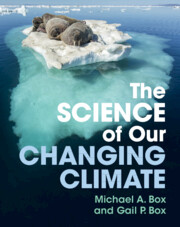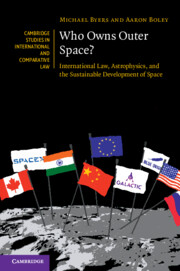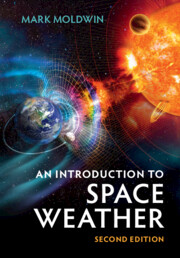23 results

The Science of Our Changing Climate
-
- Published online:
- 05 April 2024
- Print publication:
- 02 May 2024
-
- Textbook
- Export citation
2 - Mega-constellations
-
- Book:
- Who Owns Outer Space?
- Published online:
- 06 April 2023
- Print publication:
- 13 April 2023, pp 46-76
-
- Chapter
-
- You have access
- Open access
- HTML
- Export citation
3 - Mega-constellations and International Law
-
- Book:
- Who Owns Outer Space?
- Published online:
- 06 April 2023
- Print publication:
- 13 April 2023, pp 77-113
-
- Chapter
-
- You have access
- Open access
- HTML
- Export citation
7 - Space Security
-
- Book:
- Who Owns Outer Space?
- Published online:
- 06 April 2023
- Print publication:
- 13 April 2023, pp 258-299
-
- Chapter
-
- You have access
- Open access
- HTML
- Export citation

Who Owns Outer Space?
- International Law, Astrophysics, and the Sustainable Development of Space
-
- Published online:
- 06 April 2023
- Print publication:
- 13 April 2023
-
- Book
-
- You have access
- Open access
- Export citation

An Introduction to Space Weather
-
- Published online:
- 12 November 2022
- Print publication:
- 01 December 2022
-
- Textbook
- Export citation
7 - Verification
-
- Book:
- Nuclear Weapons
- Published online:
- 14 October 2021
- Print publication:
- 04 November 2021, pp 174-197
-
- Chapter
- Export citation
A high efficiency 10W MMIC PA for K-b and satellite communications
-
- Journal:
- International Journal of Microwave and Wireless Technologies / Volume 13 / Issue 6 / July 2021
- Published online by Cambridge University Press:
- 31 March 2021, pp. 582-594
-
- Article
-
- You have access
- Open access
- HTML
- Export citation
Part II - The Generative/Productive Cold War
-
- Book:
- International Law and the Cold War
- Published online:
- 05 December 2019
- Print publication:
- 19 December 2019, pp 79-336
-
- Chapter
- Export citation
7 - Shadowboxing: The Data Shadows of Cold War International Law
- from Part II - The Generative/Productive Cold War
-
-
- Book:
- International Law and the Cold War
- Published online:
- 05 December 2019
- Print publication:
- 19 December 2019, pp 137-158
-
- Chapter
- Export citation
Satellite Measurement of GHG Emissions: Prospects for Enhancing Transparency and Answerability under International Law
-
- Journal:
- Transnational Environmental Law / Volume 8 / Issue 2 / July 2019
- Published online by Cambridge University Press:
- 15 May 2019, pp. 303-326
-
- Article
- Export citation
The contribution of space for a more sustainable earth: leveraging space to achieve the sustainable development goals
- Part of
-
- Journal:
- Global Sustainability / Volume 2 / 2019
- Published online by Cambridge University Press:
- 11 February 2019, e3
-
- Article
-
- You have access
- Open access
- HTML
- Export citation
Hubble Space Telescope observations of Europa in and out of eclipse
-
- Journal:
- International Journal of Astrobiology / Volume 9 / Issue 4 / October 2010
- Published online by Cambridge University Press:
- 24 August 2010, pp. 265-271
-
- Article
- Export citation
Water on Planets
-
- Journal:
- Proceedings of the International Astronomical Union / Volume 5 / Issue H15 / November 2009
- Published online by Cambridge University Press:
- 21 October 2010, pp. 29-44
- Print publication:
- November 2009
-
- Article
-
- You have access
- Export citation
Identification modale d'un satellite en campagne de qualification
-
- Journal:
- Mechanics & Industry / Volume 7 / Issue 4 / July 2006
- Published online by Cambridge University Press:
- 07 February 2007, pp. 325-331
- Print publication:
- July 2006
-
- Article
- Export citation
Parametric analysis of ply properties on composite cylinder design for spacecrafts
-
- Journal:
- Mechanics & Industry / Volume 7 / Issue 1 / January 2006
- Published online by Cambridge University Press:
- 10 May 2006, pp. 57-62
- Print publication:
- January 2006
-
- Article
- Export citation
Commission 6: Astronomical Telegrams†
-
- Journal:
- Proceedings of the International Astronomical Union / Volume 1 / Issue T26A / December 2005
- Published online by Cambridge University Press:
- 01 December 2005, pp. 335-336
- Print publication:
- December 2005
-
- Article
-
- You have access
- Export citation
Commission 16: Physical Study of Planets and Satellites
-
- Journal:
- Proceedings of the International Astronomical Union / Volume 1 / Issue T26A / December 2005
- Published online by Cambridge University Press:
- 01 December 2005, pp. 143-152
- Print publication:
- December 2005
-
- Article
-
- You have access
- Export citation
Remote sensing in Antarctica and the Southern Ocean: applications and developments
-
- Journal:
- Antarctic Science / Volume 2 / Issue 2 / June 1990
- Published online by Cambridge University Press:
- 14 May 2004, pp. 105-121
-
- Article
- Export citation
Estimation of Minimum Separation of Geostationary Satellites for Satellite-Based Augmentation System (SBAS) from Equatorial Ionospheric Scintillation Observations
-
- Journal:
- The Journal of Navigation / Volume 56 / Issue 1 / January 2003
- Published online by Cambridge University Press:
- 27 January 2003, pp. 137-142
- Print publication:
- January 2003
-
- Article
- Export citation



